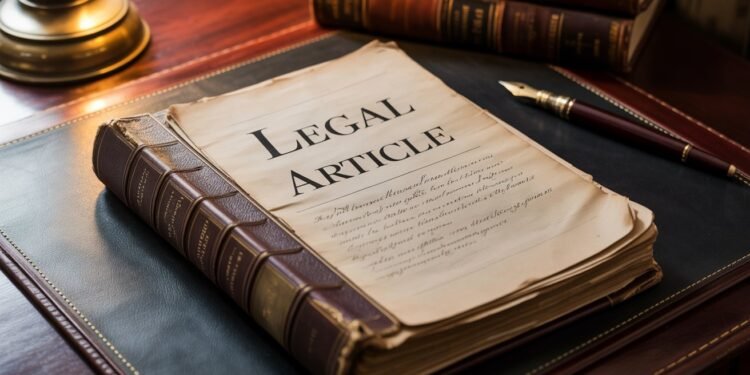This article is written by R. Antony Robinson third year student BA.LLB (Hons.) of Dr. Ambedkar Global Law Institute
Abstract
Victimology is significant in the cruel world and it is useful for the victims and their families. The criminal justice system in India has traditionally focused on punishing offenders, often sidelining the experiences, rights, and needs of victims. However, with the evolution of victimology as an academic and legal discipline, there is a growing recognition of victims as the point of central in the view of justice. This paper explores the theoretical foundations of victimology and critically examines the legal and institutional framework for victim protection in India. It discusses the rights of victims during criminal proceedings, the special provisions for vulnerable categories such as women, children, and marginalized communities, and the role of victim assistance programs in ensuring rehabilitation and support. Despite several progressive legislations and judicial pronouncements, challenges persist in the implementation of victim-centric measures due to systemic, societal, and infrastructural limitations. By comparing international best practices, this study highlights India’s relative lag in establishing a comprehensive and enforceable victims’ rights regime.
Introduction
➢ Victim is the term used to mention the person who is aggrieved or injured or harmed person by the guilty person.
➢ The Victimology is basically the study of victims with their position, experience, character and their role in the judiciary system.
➢ Our old Indian Judiciary system, focuses to use the Retributive theory of punishment for any criminal activities involved by any person
➢ Retributive theory, is mainly focuses ‘to suffer the same’ means, the person who done any harm or causing any injury to another person, that person will receive the same as punishment and suffer the same pain, so he could never do this again in his lifetime.
➢ But later, we change the Retributive ( revenge ) theory to Reformative ( forgive) theory, in our legal system.
➢ Reformative theory, focus on sentiment and emotional treatment, this theory will perform to give counselling and give mental treatment, many of them believe in this theory, to the offensive persons.
➢ Our Indian Criminal laws are only focusing on the Offenders only, so the study of victimology helps us to understand about the victims.
➢ The Courts main role is to find out the victims and the offenders, so the aggrieved person can get the relief.
➢ Now, in this Article we going to see about how victims are summarised in criminal law and the rights and remedies of the victims.
Keywords
Victim, concept of Victimology, protection and Application of Victimology in India, Judicial role in victimology, Victimology’s role and it’s practical challenges.
Theoretical framework of Victimology
We going to see about the theories, which framed the victimology theories in the Indian Judiciary system,
- Positivist Victimology
The positivist Victimology focuses on the characters of the Victims and their role in the society. For e.g. the person who views the fight between other two persons, the
person who go for late night walks with a chance to doubt as thief, the person who watches the accident (with or without knowledge), these all the persons will be choose by the police officers for the investigation procedures, in sometimes he also added as liable person in the crime.
- Radical Victimology
Radical Victimology, is a significant which for one mistake or crime done by others, it would be likely targeted by a particular group or individuals, it seen not just the victims but also victims economic background, social pressures. For e.g. if a person arrested for rape of a minor, which is done by others how the society looks that person and treat that person is totally different, until he proved in the court of justice.
- Critical Victimology
The Critical Victimology examines how the society looks the victims character and structural formations they face in the Indian Territory, this will actually frame the victims into the legal system of India. For e.g. the sexual worker, prostitute getting arrested for sexual crimes. It clearly explain how the Legal system clarifies the victimhood.
- Application in India
These theories were enforce in the Indian Legal system and give supports to the victims in the India for many crimes and give solutions and reasons to the societal problems with the victims. Victimology plays a ideal role in the Indian Legal system for the problems including,
❖ Treatment of rape victims
❖ Acid attack survivors and
❖ Scheduled Caste ( SC ) and Scheduled Tribe ( ST ) Victims
Like these problems can be given counselling services by these theories, many thinkers in all over the countries had played a remarkable role and graded by application of these theories. Many thinkers like Von Hentig and Stephen Schafer were remembered in the Indian context also.
Legal protection for victims in India
There are many Laws available in the India to provide the legal protection to the victims namely,
1) Code of Criminal Procedure (CrPC), 1973
In CRPC, there are two sections which defines about the legal protection for the victims in India,
- Section 357: This section which deals with the compensation to the victims in India legal jurisdiction
- Sections 154,161,164: These sections which deals with the Procedural safeguards of the victims which is especially in the sexual offences.
So, we can use these sections under the CrPC, in Indian jurisdiction.
2) Victim compensation Scheme
In Indian legal jurisdiction, victim compensation Scheme can be issued under the Section 357A of CrPC1 which mentions that the State has the obligation to separate and establish funds.
3) Constitutional provisions
The Constitutional Law is the mother law of all the laws in the India, so no other law can overrule the Constitutional Articles, there are two basic fundamental articles for the victims for their legal protection,
- Article 21 – This article which mentions, that every person has the Right to Life and liberty as a basic fundamental rights, but this article also carrying that Right to dignity ( respect ) is also included in the Article 21.
- Article 14 – This article mentions, that no one should be above law and no one is below the law, everyone is same and equal from birth to death, Equality before the law has to be maintained without any bias and partiality.
4) Judicial Recognition
1 The Code of Criminal Procedure, 1973, No. 2 of 1974, § 357A, inserted by The Code of Criminal Procedure (Amendment) Act, No. 5 of 2009, India Code (2009)
Judicial system has played a major role in shaping up legal structure for the welfare of the victims in many cases, the famous quote also there “Even hundred criminals can escape, but even one innocent should punished” according to this quote our Judicial system is running, the one of the reference case is, Delhi domestic working women’s forum v. Union of India2, in this case Supreme Court Justice mentioned the concept of Right to free legal aid and the counselling to the parties of the case, who is below the average source of income can get this right and The Government should arrange recognised pleader to argue for their case and bring the Justice in the case, and Government will provide the monthly salary for the legal aid advocate according to their capabilities and skills.
5) Schemes
The judiciary had interpreted and Government had announced various schemes to the victims and their family to their welfare and to face their future economic development. Some schemes are Nirbhaya fund, Ujjawala Scheme and Etc., have been made for the victims who faced so many critical situations by the criminals and spent much money on the court to secure the Justice in Court. So, for these problems the schemes are announced for their next future career development, by these funds it can be beneficial for them and their whole family.
Rights of Victims in Criminal proceedings
➢ Right to be heard : The rights of the victims should be heard with full sense mainly while applying bail petitions, parole and while giving sentence to stages for the victims, it is clearly mentioned in the Mallikarjun kodagali v. State of Karnataka3, this case is good reference and good example for the Right to be heard.
➢ Right to information : The right to information is basic rights for the victims mainly to know about any details like trial status, the victims investigation and also he can know about the compensation available to the victim, he have these rights to know about it and their details.
2 Delhi Domestic Working Women’s Forum v. Union of India, (1995) 1 S.C.C. 14 (India) 3 Mallikarjun Kodagali v. State of Karnataka, (2019) 2 S.C.C. 752 (India)
➢ Right to legal aid and assistance : The victim can get legal aid or free legal aid and their assistance for their case to represent the victim in the court, this can be done through the procedures and process in the CrPC and the guidelines and consent of the Supreme Court in India.
➢ Right to protection : The concerned Court victims are to be protected and safeguarded under the judicial custody and under the direct view of judges, the police officers also strictly ordered to safeguard the victims, from any retaliation and from the intimidation to the victims from any strangers.
➢ Right to compensation : The victims should get the relief and the sum of the amount from the offensive person as compensation and given it to the victims, and right to rehabilitation is also one of their right.
Special provisions for vulnerable victims
There are many provisions available for the vulnerable victims namely,
➢ For Women victims : There are many Acts and statutes available for the women that are Protection Of Children from Sexual Offences (POCSO) Act, 2012 is for the minor girls sexual harassment or rape, Domestic Violence Act, 2012 for the wife’s safety in the house, Sexual Harassment of Women at workplace Act,2013 it is one of the Act while is implemented after the Vishaka & ors. V. State of Rajasthan4it is one of them landmark judgement case for women’s safety in workplace.
➢ For child victims : There are many Acts present in India for the protection of Children from any harm activities, namely Juvenile Justice Act, 2015 for the protection of child adoption, marriage, and some etc., is managed by JJ Act. POCSO procedures is also there for the children to make child-friendly procedures and in practical usage.
4 Vishaka v. State of Rajasthan, (1997) 6 S.C.C. 241 (India)
➢ For SC/ ST Victims : In India, the many conflicts arising from the caste to caste conflicts. The higher caste group peoples will dominate the lower caste groups in all the places, they will restrict the lower caste groups. If the lower caste groups didn’t follow the rules of higher caste groups they will kill and harm the lower caste groups. So, for that kind of situations this Act like Protection under SC/ ST (Prevention of atrocities) Act, 1989 this Act will helpful for the Scheduled people’s from the dominant caste peoples.
Like these there are many Acts available for the welfare of the citizens in the India to protect themselves by Legal system.
Victim Assistance Program
There are many programs available for the victims, which it may be useful for themselves and their family members some are,
❖ The Victim Compensation scheme which is useful for their future career and economic development (especially in the states like Delhi, Maharashtra, Tamil Nadu) ❖ Rehabilitation homes is available for the victims mainly due to control the fear of the victims, rape involved person to give counselling and acid attack persons to change the mind set of these kind of persons. Trauma centres also available for the victims usage.
❖ All the victims must be sent to all the counselling’s by legal side, medical counselling examination, and also seek for the police officers to help the victims.
Challenges in Implementation
There are many challenges facing by the Government in Implementing these programs and laws in India namely,
➢ Due to insufficient funds and taking too much time for settling the amount for the victims and their families.
➢ There is no laws for victims and there is no universal and same law for the victims for their welfare rights.
➢ The Victims would be largely blaming while in the courts cross – examination, and secondary victimization is available while during the trial of the court.
➢ The availability of the poor witness will leads to the poor implementation of the witness, there are many Supreme Court cases also deals with it.
➢ The Justice which is delay, the Victims has to face social problems in the society, especially in the rape, sexual cases will have different from of feeling with the victims, while facing the social stigma.
➢ There is no sufficient training to the judiciary officers/ Judges and to the Police officers, in the India, so faced lot of challenges in implementation of the Victimology in India.
Conclusion
As the conclusion to our part, Victimology is should be implemented in the India because it is the growing discipline and also it restores with the balanced Indian Legal System. We have to remind this always that victims are not offensive persons, they are also the right holders and fundamental rights also reserved for them. In previously our thoughts is filled based on giving punishment to the criminals and offensive persons but now, all the peoples mostly 80% are educated in the India, now focuses on Victims sensitive Framework. The Government should make Victim centric justice centres to making their legal remedies and social, economic remedies possible to the victims and to aim for the Justice in the Courts for the Victims.



